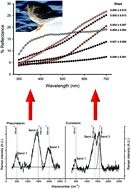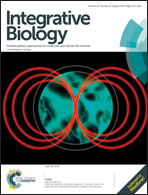Molecular vibration as a novel explanatory mechanism for the expression of animal colouration†
Abstract
Animal colouration is characterized by the concentration of pigments in integumentary structures and by the nanoscale arrangement of constitutive elements. However, the influence of molecular vibration on colour expression has been overlooked in biology. Molecular vibration occurs in the infrared spectral region, but vibrational and electronic properties can influence each other. Thus, the vibration of pigment molecules may also affect their absorption properties and the resulting colours. We calculated for the first time the relative contribution of molecular vibration (by means of Raman spectroscopy) and concentration (by means of HPLC) of melanin polymers, the most common animal pigments, to generate diversity in plumage colour in 47 species of birds. Vibrational characteristics explained >9 times more variance in colour expression than the concentration of melanins. Additionally, we modelled melanin Raman spectra on the basis of the chemical structure of their constituent monomers and calculated the Huang–Rhys factors for each vibrational mode, which indicate the contribution of these modes to the electronic spectra responsible for the resulting colours. High Huang–Rhys factors frequently coincided with the vibrational modes of melanin monomers. Our results can be explained by the influence of molecular vibration on the absorption properties of melanins. The colour of organisms may thus mainly result from the vibrational properties of their molecules and only residually from their concentration. As a given melanin concentration can give rise to different colours because different structural melanin conformations can present different vibrational characteristics, vibrational effects may favour phenotypic plasticity and thus constitute an important evolutionary force.



 Please wait while we load your content...
Please wait while we load your content...